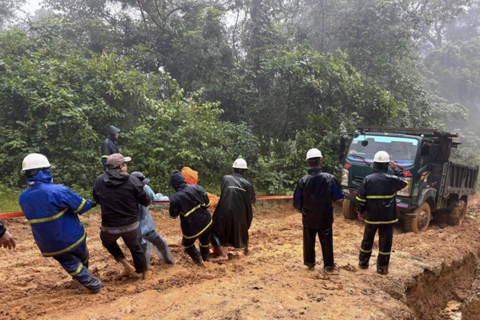UNDP partners with Vietnam towards goal of poverty eradication
The Vietnamese Government will strengthen bilateral/multilateral cooperation with international partners to realize multidimensional, inclusive, and sustainable poverty reduction.
The United Nations Development Program (UNDP) and the National Coordination Office for Poverty Reduction, Ministry of Labour-Invalids and Social Affairs (MoLISA) on February 28 signed a Memorandum of Understanding towards the goal of poverty eradication in all aspects.
| Participants at the signing ceremony. Photo: TTXVN |
Speaking at the event, Le Van Thanh, Deputy Minister of Labour, Invalids and Social Affairs, highly appreciated the cooperation between the Australian Department of Foreign Affairs and Trade (DFAT), the UNDP, and the National Office for Poverty Reduction.
He said the ministry wanted to strengthen bilateral/multilateral cooperation with international partners to successfully realize multidimensional, inclusive and sustainable poverty reduction, towards the goal of poverty eradication in all its dimensions.
This is also part of the Government's Decision No. 90 on the National Target Program for Sustainable Poverty Reduction in the 2021-2025 period, he added.
As one of the activities to concretize the agreement, the UNDP-MoLISA-DFAT project, themed “Building programs and policy consultation on multi-dimensional and sustainable poverty reduction, in 2021-2023”, has provided technical support to the MoLISA for researching ad proposing a number of contents of the National Target Program for Sustainable Poverty Reduction in the 2021-25 period.
Through technical assistance, the poverty reduction program in the next period will be developed in many innovative ways that are suitable to the requirements of the current context, creating a more open mechanism for local authorities and people to promote the internal resources of the community.
The program also applies innovative solutions that have been successfully tested to bring efficiency for projects that support livelihood development, generate income and mobilize businesses to participate in value chain development, accompanying people to provide technical assistance to improve income.
| A local grower is harvesting his flowers at his farming area in Hanoi's Me Linh District. Photo: Tung Nguyen |
According to the MoLISA, the National Target Program for Sustainable Poverty Reduction in the 2021-25 period has new points compared to the previous 2016-20 period. The program focuses on investing in capacity building for the poor, clearly identifying the causes of poverty in order to radically and thoroughly solve the problems of the poor and poor areas. The method of supporting the poor has also changed in the new period.
The project has made proposals for digital transformation solutions in the management and implementation of the National Targeted Program on Sustainable Poverty Reduction in 2021-25, through which information and results of program implementation would be provided timely and effectively to stakeholders.
UNDP Resident Representative in Vietnam Caitlin Wiesen said through the signed MoU, the UNDP and GREAT/DFAT will continue to provide policy advice and technical support for the MoLISA to expand the scale of innovative solutions, which have been successfully tested, and reach the program's goal of reducing the number of poor and near-poor households by half by 2025.
“Our tried and tested innovative solutions will be applied more widely to help meet the National Targeted Program’s objective of reducing the number of poor and near-poor households by half by 2025,” said Caitlin Wiesen.
Australian Ambassador to Vietnam Robyn Mudie also said Australia is committed to supporting sustainable and inclusive growth in Vietnam. The launch of the UNDP-MoLISA partnership was part of Australia's commitment.
She underlined Australia appreciated the cooperation and will recommend Vietnam to research, develop, and implement innovative solutions to poverty alleviation.
Vietnam’s poverty rate declined to 2.23% in 2021 from 2.75% in 2020, according to the MoLISA. By the end of 2021, the country had 609,049 poor households, while the number of near-poor households was 850,202, representing 3.11%.
Hanoi, along with five localities including Haiphong, Danang, Ho Chi Minh City, Binh Duong, and Tay Ninh reported no poor households.












